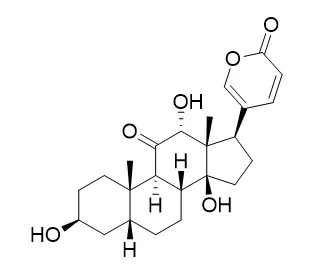| In vitro: |
| Toxicon. 2016 Feb;110:27-34. | | Bufadienolides from parotoid gland secretions of Cuban toad Peltophryne fustiger (Bufonidae): Inhibition of human kidney Na(+)/K(+)-ATPase activity.[Pubmed: 26615828] | Parotoid gland secretions of toad species are a vast reservoir of bioactive molecules with a wide range of biological properties.
METHODS AND RESULTS:
Herein, for the first time, it is described the isolation by preparative reversed-phase HPLC and the structure elucidation by NMR spectroscopy and/or mass spectrometry of nine major bufadienolides from parotoid gland secretions of the Cuban endemic toad Peltophryne fustiger: ψ-bufarenogin(Pseudobufarenogin), gamabufotalin, bufarenogin, arenobufagin, 3-(N-suberoylargininyl) marinobufagin, bufotalinin, telocinobufagin, marinobufagin and bufalin. In addition, the secretion was analyzed by UPLC-MS/MS which also allowed the identification of azelayl arginine. The effect of arenobufagin, bufalin and ψ-bufarenogin(Pseudobufarenogin) on Na(+)/K(+)-ATPase activity in a human kidney preparation was evaluated. These bufadienolides fully inhibited the Na(+)/K(+)-ATPase in a concentration-dependent manner, although arenobufagin (IC50 = 28.3 nM) and bufalin (IC50 = 28.7 nM) were 100 times more potent than ψ-bufarenogin (Pseudobufarenogin,IC50 = 3020 nM).
CONCLUSIONS:
These results provided evidence about the importance of the hydroxylation at position C-14 in the bufadienolide skeleton for the inhibitory activity on the Na(+)/K(+)-ATPase. | | Oncotarget. 2015 May 10;6(13):11627-39. | | ψ-Bufarenogin, a novel anti-tumor compound, suppresses liver cancer growth by inhibiting receptor tyrosine kinase-mediated signaling.[Pubmed: 25890498 ] | Resistance of hepatocellular carcinoma (HCC) to existing chemotherapeutic agents largely contributes to the poor prognosis of patients, and discovery of novel anti-HCC drug is in an urgent need.
METHODS AND RESULTS:
Herein we report ψ-Bufarenogin(Pseudobufarenogin), a novel active compound that we isolated from the extract of toad skin, exhibited potent therapeutic effect in xenografted human hepatoma without notable side effects. In vitro, ψ-Bufarenogin suppressed HCC cells proliferation through impeding cell cycle progression, and it facilitated cell apoptosis by downregulating Mcl-1 expression. Moreover, ψ-Bufarenogin decreased the number of hepatoma stem cells through Sox2 depression and exhibited synergistic effect with conventional chemotherapeutics. Mechanistic study revealed that ψ-Bufarenogin impaired the activation of MEK/ERK pathway, which is essential in the proliferation of hepatoma cells. ψ-Bufarenogin notably suppressed PI3-K/Akt cascade, which was required in ψ-Bufarenogin-mediated reduction of Mcl-1 and Sox2. ψ-Bufarenogin inhibited the auto-phosphorylation and activation of epithelial growth factor receptor (EGFR) and hepatocyte growth factor receptor (c-Met), thereafter suppressed their primary downstream cascades Raf/MEK/ERK and PI3-K/Akt signaling.
CONCLUSIONS:
Taken together, ψ-Bufarenogin suppressed HCC growth via inhibiting, at least partially, receptor tyrosine kinases-regulated signaling, suggesting that ψ-Bufarenogin could be a novel lead compound for anti-HCC drug. |
|






 Cell. 2018 Jan 11;172(1-2):249-261.e12. doi: 10.1016/j.cell.2017.12.019.IF=36.216(2019)
Cell. 2018 Jan 11;172(1-2):249-261.e12. doi: 10.1016/j.cell.2017.12.019.IF=36.216(2019) Cell Metab. 2020 Mar 3;31(3):534-548.e5. doi: 10.1016/j.cmet.2020.01.002.IF=22.415(2019)
Cell Metab. 2020 Mar 3;31(3):534-548.e5. doi: 10.1016/j.cmet.2020.01.002.IF=22.415(2019) Mol Cell. 2017 Nov 16;68(4):673-685.e6. doi: 10.1016/j.molcel.2017.10.022.IF=14.548(2019)
Mol Cell. 2017 Nov 16;68(4):673-685.e6. doi: 10.1016/j.molcel.2017.10.022.IF=14.548(2019)